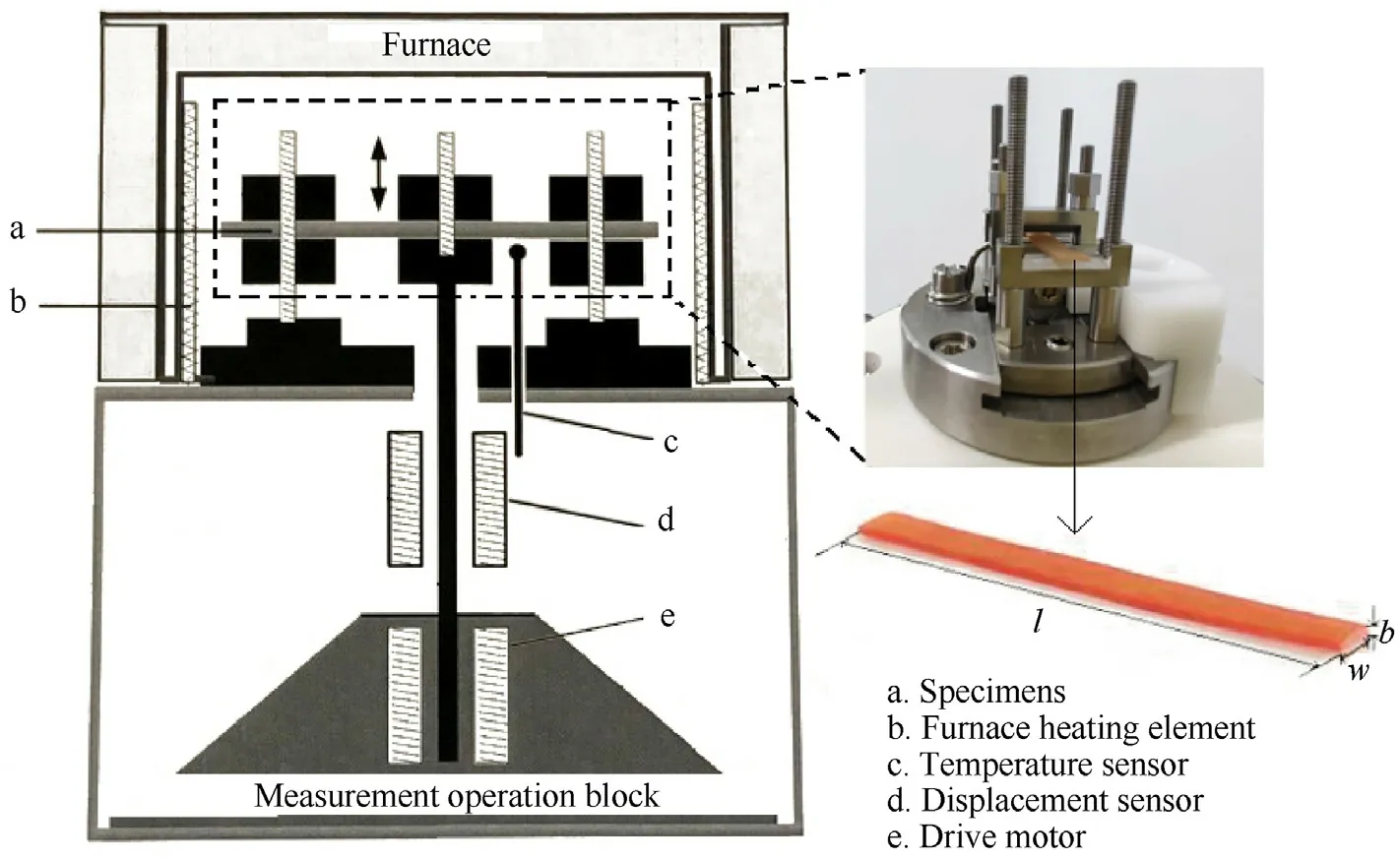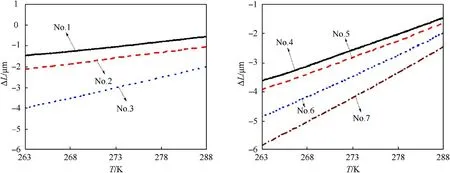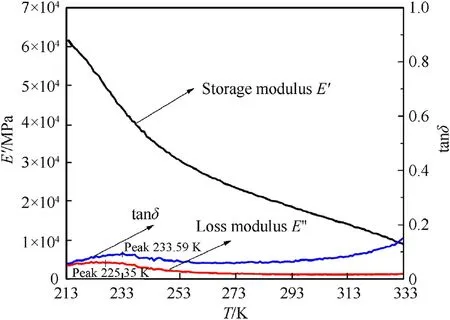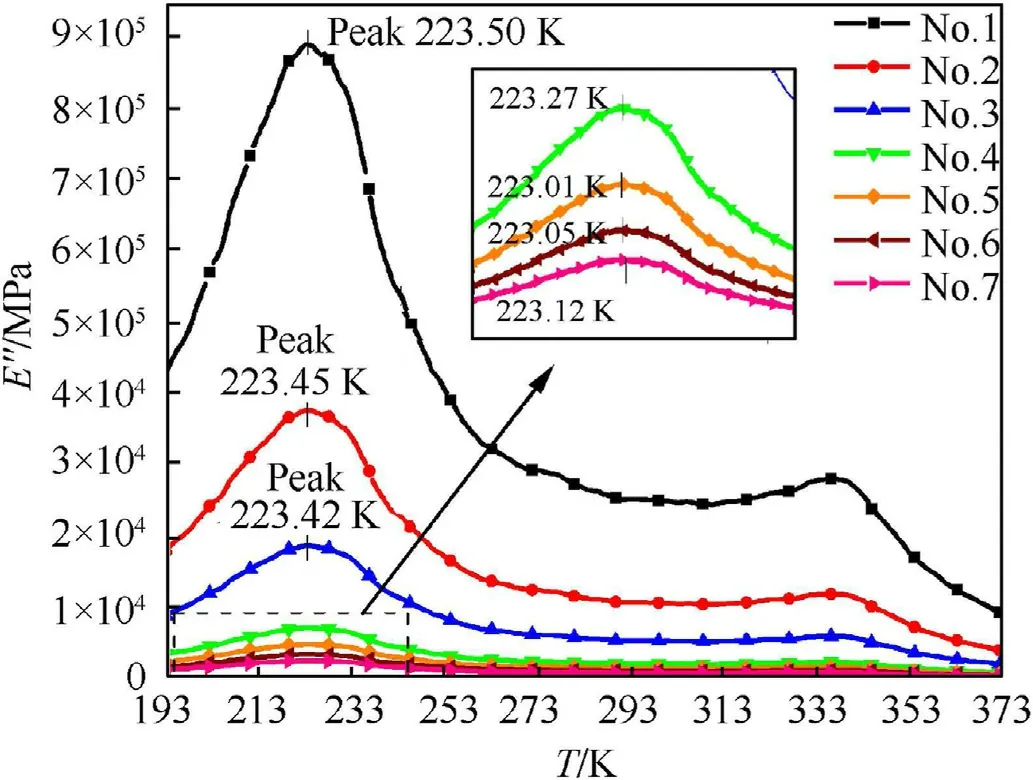A novel modification method for the dynamic mechanical test using thermomechanical analyzer for composite multi-layered energetic materials
Le Qi , Shi-lin Zhng , Ho Yun , Zhong-ling M ,*, Zhong-ling Xio
a School of Environment and Safety Engineering, The North University of China, Taiyuan, 030051, China
b School of Chemical Engineering, The Nanjing University of Science and Technology, Nanjing, 210094, China
Keywords:Thermo-mechanical analyzer (TMA)Dynamic mechanical analyzer (DMA)Modified Time-temperature equivalence principle
ABSTRACT Herein, we present a thermo-mechanical analyzer (TMA) and dynamic mechanical analyzer (DMA) of composite multi-layered gun propellant, focusing on thermal expansion coefficients and dynamic thermomechanical properties. The linear thermal expansion coefficient of the prepared energetic material is determined as approx. 0.1800 × 10-4 - 0.2081 × 10-4 K-1. According to DMA test and dynamic thermomechanical properties, the glass transition temperature is also obtained. The tested value is within the range of 223.01-223.50 K,which indicates the lower limit of the energetic material.However,DMA tests reveal temperature changes, which occur due to thermal expansion. Moreover, the geometrical factor decreases with increasing temperature.Therefore,thermal expansion significantly affects the storage modulus and loss modulus.Additionally,the thermal expansion coefficient can be used to modify the storage and loss modulus.The results show that the proposed method provides effective and reliable modified results.
1. Introduction
Double-based (DB) gun propellant is produced from mixing nitrocellulose and nitroglycerine with small amounts of other auxiliary materials [1,2]. DB propellants are widely used for medium and small caliber weapons;hence,many studies have focused on improving their combustion performance [3,4]. The composite multi-layered flake gun propellant has good burning progressivity,which can effectively improve the muzzle velocities of the gun's projectile.Additionally,the mechanical properties of the composite multi-layered flake gun propellant are similar to that of general polymers [5,6]. Therefore, a testing method for general polymers can be used for this composite multi-layered flake gun propellant.
Thermo-mechanical analyzer(TMA)is commonly used to study the thermal expansion of energetic materials. The thermal expansion coefficient of octahydro-1,3,5,7-tetranitro-1,3,5,7-tetrazocine(HMX) has been measured over the temperature range of 58-253 K using TMA. Furthermore, the coefficient of thermal expansion (CTE) value is affected by the temperature range and heating rate, and is within the range of 51-66 × 10-6K-1[7].Thermo-mechanical analyzer (TMA) technique has been used to characterize the thermomechanical properties of carbon nanotubes and graphene nano-platelets[8].This approach has proven to be a simple and effective method to measure the glass transition temperature [9]. Victor et al. investigated the nitramine-based amorphous energetics using TMA, and found that the material's softening was associated with the glass transition at approx.323 K[10]. The relaxation transitions, surface tension, and porosity of nitrocellulose have been studied using TMA and dynamic mechanical analyzer (DMA), where three small relaxation transitions of nitrocellulose can be observed, which are contained in gun propellant at 233 K, 308 K, and 353 K [11,12]. CTE of TATB (1,3,5-triamino-2,4,6-trinitrobenzene) based explosives has been measured using TMA within the temperature range of 300-566 K,in which the axial and radical CTE are 2.7 × 10-6K-1and 48 × 10-6K-1, respectively, which indicate a small degree of alignment of TATB molecules under uniaxial compression [13,14].
The thermo-mechanical properties tests can be divided into TMA and DMA tests. Furthermore, the thermo-mechanical properties of DB gun propellants influence their proper functioning,which has been the critical focus of many studies. In our previous works, linear thermal expansion coefficient of composite multilayered flake gun propellant was measured using TMA method[3,15]. DMA method can also be used to study the thermal expansion coefficient. However, this method is complicated [16]. It is known that the glass transition temperature is related to phase change and can be evaluated using several techniques, which are attributed to the frequency effect.The glass transition temperature obtained using DMA and temperature modulated differential scanning calorimetry (TMDSC) are different [17-19]. The glass transition temperature of automotive coatings has been measured using TMA and DMA. Reports have shown that the correlation between the temperature of midpoint in DSC, the onset temperature of TMA,and the onset temperature of loss modulus using DMA at low frequencies is good. However, this correlation decreases at high frequencies [20,21]. Most glass transition temperatures of energetic materials have been studied using DMA method[22-24],including perfluorosulfonic acid ionomers.The graph between tanδ and temperature shows four distinct peaks. The glass transition temperature of H+from Nafion corresponds to a weak β-relaxation that is centered at 253 K[25].Furthermore,DMA method is widely used in the research of double-based solid propellant to study the glass transition temperature [26,27]. The dynamic mechanical properties of double-based rocket propellant have been studied at 353 K, 358 K, and 363 K, where the storage and loss modulus depend on temperature and time. However, the prediction of the propellant's artificially aged time has been determined to be unreliable above 333 K [28]. The viscoelastic parameters obtained from DMA measurement can be optimized using a genetic algorithm, which are matched with the experimental results at different temperatures, strain rates, and pressures [29]. Additionally,DMA technique can be used to predict the artificially aged time of the propellant by storage modulus [30].
The purpose of this work is to provide a fundamental background on the method of modifying the dynamic mechanical test results using thermo-mechanical analyzer for energetic materials,which provides a modified reference for DMA method. TMA and DMA tests are used to describe the thermo-mechanical properties of the energetic material. Moreover, frequency sweep curves are obtained using DMA. According to the thermal expansion coefficient, modification of the storage and loss modulus is an effective and reliable method.
2. Theoretical backgr ound
In DMA the dynamic mechanical behavior of a material acts as a function of frequency and temperature. The sample mounted in DMA is subjected to a predefined mechanical oscillation program,defined by the frequency and amplitude,and temperature program.The dynamic displacement of the sample during the mechanical oscillation program is measured.The phase lag angle δ between the applied stimulus and the response is also obtained using the displacement measurement.Additionally,a force signal is produced based on the force exerted on the sample by the drive motor.
The force and displacement are denoted as F and L,respectively.The complex modulus E*can be calculated using Eq. (1).
where the ratio F/L is defined as the stiffness S, and g is known as the geometrical factor, which is calculated from the sample's dimensions. Both S and g are calculated using Eq. (2) and Eq. (3),respectively.
where g is the geometrical factor for three-point bending specimen,and l, w, and b are the geometric dimensions of the sample identified in Fig.1.A schematic diagram of DMA test is shown in Fig.1.

Fig.1. Schematic of functional principle of DMA.
During DMA method, as temperature increases, the thermal expansion of specimens affects their geometry. The probe's pressure on specimens is 0.05 N in TMA method,whereas in the case of DMA method there is 1 N pressure on the upper clamp bar to ensure the assumed amplitude value can be 10 μm.The geometrical factor(g) can be corrected by the thermal expansion coefficient of the specimen during the heating process at the same heating rate and temperature range.
Therefore, a method is required that is suitable for composite multi-layered flake gun propellant, which is easy to apply and calculate.The purpose of this paper is to describe such a method to correct for the effect of temperature on geometrical factor.Thermal expansion of the specimen in the thickness direction is considered,and the linear thermal expansion coefficient of the specimen is defined as α. When combined with the definition of thermal expansion coefficient,the thickness of the specimen at temperature T is expressed as Eq. (4).
where b0(T0) is the original thickness of the specimen, and b(T) is the thickness of the specimen at temperature T.Eq.(3)can also be rewritten as Eq. (5).
The complex modulus E*is expressed as Eq. (6).
Therefore, the modulus can be corrected by thermal expansion coefficient.
3. Experiment
3.1. Materials
All samples described herein were composite multi-layered flake gun propellant. The gun propellant had a layered structure.Both the inner and outer layers were composed of double-base propellant. The main component of the inner layered material was 1# double-base absorbent propellant (NC:68.2%, NG:31%,C2:0.8%, where NC is nitrocellulose, NG is nitroglycerin, C2 is centralite, the nitration level is 13.00%). The main component of the outer layered material was 2# double-base absorbent propellant(NC:88.26%, NG:10.04, C2:1.7%, the nitration level is 12.76%). The structure of the composite multi-layered flake gun propellant is shown in Fig.2,inner layer was coated by outer layer,and the inner layer was twice as thick as outer layer, the corresponding geometrical size of the samples is shown in Table 1. And the solubility parameters of nitrocellulose and alcohol/acetone mixed solvents (1:1) are similar, therefore, alcohol/acetone mixed solvents are used as solvent.

Table 1 Geometrical size of the samples composite multi-layered flake gun propellant.

Fig. 2. The structure of composite multi-layered flake gun propellant.
3.2. Thermo-mechanical analyzer (TMA)
The theory of CTE comprises the deformation of materials was determined as the temperature changes. In some temperature ranges, the linear CTE was constant. When the temperature changed, TMA measured the change in length of materials. The linear CTE of materials was calculated by measuring its deformation within a specific temperature range. The instrument's sensitivity was 0.1 μm.
Furthermore, the composite multi-layered flake gun propellant belongs to double-based gun propellant, which turns soft above 300 K. In order to reduce the influence of probe on the thickness measurement, a flat probe 3 mm in diameter was used to reduce the pressure of probe on the specimens. TMA results showed that 0.007 MPa causes false negative expansion of the sample above 300 K;however,in DMA test,the specimens were subjected to the same pressure. ΔL values were obtained at various temperature from ΔL-T curves; hence, the thickness of the specimens were modified by ΔL-T curves in DMA test.
A smooth part of the composite multi-layered flake gun propellant sample (double-base propellant) was selected. The sample was a flake shaped cuboid with the length,width and thickness of 0.5 cm, 0.5 cm, and 0.3-1.0 mm, respectively. The thermal expansion coefficient of the sample was measured using TMA-Q 400(TA instruments, USA) with 2 K/min heating rate under dry nitrogen atmosphere over the temperature range of 213-323 K. The linear CTE can be expressed using Eq. (7).
where α, Δb, b0, and ΔT are the linear CTE, change in dimension,original thickness of the material, and corresponding temperature change, respectively. The linear CTE (α) is average linear thermal expansion coefficient for the sample in the temperature range of T2to T1.
3.2.1. Dynamic mechanical analyzer (DMA)
DMA test was performed using DMA1 analyzer(Mettler Toledo)in 3-point bending mode with the sample dimensions of 60 ± 0.05× 7 ± 0.05 ×b0(0.3-1.0) mm.A liquid nitrogen cooling accessory was used for the experiments. The non-isothermal measurements were conducted within the temperature range of 273-393 K at the heating rate of 2 K/min and loading frequency of 1 Hz. The amplitude of the test sample's deformation was established at ±10 μm. The isothermal measurements were carried out over the frequency range of 100-0.01 Hz with 10 data points for each order of magnitude. Moreover, the amplitude was 10 μm for the temperatures of 228 K, 263 K, and 293 K.
4. Experimental results and analysis
4.1. TMA test results
TMA linear thermal expansion curve of specimens with thickness between 0.3 and 1.0 mm, scanned within the temperature range of 263-283 K,is shown in Fig.3.The obtained results showed that the curves were all linear.Between this temperature range,the linear thermal expansion coefficient lied within the range of 0.1800 × 10-4- 0.2081 × 10-4K-1, whereas the linear CTE increased with increasing sample thickness (see Table 2). The composite multi-layered flake gun propellant expansion during this stage was mainly caused by thermal expansion of nitrocellulose. The specimens were extruded under 5 MPa pressure in the forming process.However,solvent still remained in the specimens,as well as having creep recovery characteristics. In the forming process, as the sample was extruded by smaller export molds, the thickness direction of the sample experienced high pressure. The nitrocellulose was also subject to greater bondage stress. As the stress disappeared,nitrocellulose molecule rebounded greatly,and the solvent in the samples was completely volatilized after a long period of time. Hence, nitrocellulose molecule recovery occurred.During TMA test, as the temperature increased, the thermal expansion rebounding of nitrocellulose molecule in samples of smaller thicknesses was small. Therefore, the linear CTE increases with increasing thickness.

Table 2 Linear thermal expansion coefficient of composite multi-layered flake gun propellant.

Table 3 Transition temperature of composite multi-layered flake gun propellant.
The ΔL-T curves of composite multi-layered flake gun propellant with different thickness values within the temperature range of 233-323 K is shown in Fig.4.There was an obviously turning point on each curve at about 300 K,which indicated that the sample had softened above this transition temperature.Therefore,the thermal expansion coefficient of composite multi-layered flake gun propellant could not be calculated by Eq. (4) at temperatures beyond 300 K. This was due to the sample being compressed because of probe pressure beyond 300 K. As a result, a false negative expansion trend above 300 K was observed. However, ΔL-T curves showed shape variable values of thickness for composite multi-layered flake gun propellant with temperatures above 300 K.

Fig. 3. Relationship between ΔL and T of composite multi-layered flake gun propellant (263-283 K).

Fig. 4. Relationship between ΔL and T of composite multi-layered flake gun propellant (233-323 K).
According to the mechanism of the interaction of nitrocellulose and nitroglycerin, the essence of the interaction between the nitrocellulose macromolecule and nitroglycerin molecule was that nitroglycerin swelled or dissolved nitrocellulose. The gravitational force between nitrocellulose and nitroglycerin decreased with increasing temperature. Below 300 K, the nitrocellulose macromolecular chain froze. Low molecular energy was insufficient to overcome the molecular bond rotation of barrier potential,in which only small molecular units could move.Therefore,it was unable to achieve conformational shift. Above 300 K, most of the molecular chain started to move,and the molecular kinetic energy increased and overcame the molecular bond rotation of barrier potential. It was found that even some part of the molecular chain slipped.This phenomenon was realized with a decrease in stiffness. As a result,the samples turned soft and were not sufficiently stiff to withstand the probe pressure of 0.05 N. Meanwhile, the probe was partially embedded into the sample,and showed a false negative expansion above 300 K.Therefore,there was an obvious turning point on ΔL-T curves.
The transition temperature decreased with increasing thickness within the range of 0.3-0.7 mm. However, the transition temperature of No.5, No.6, and No.7 was approximately 300 K due to the nitrocellulose molecule in thinner samples being rebounded greatly. Hence, more energy was required to make the molecular chain move. Therefore, the transition temperature decreased with increasing thickness. When the thickness of specimen was greater than 0.7 mm, the content of solvent in the specimens was comparable. Due to the addition of solvent, the swelling phenomenon occurred, which increased the distance of nitrocellulose molecule,and the thicker specimens exhibited similar free volume fraction with thinner specimens. Therefore, No.5, No.6, and No.7 had the same transition temperatures.
4.1.1. DMA test results
In Fig. 5, the reference temperatures for loss modulus and loss factor were 223.42 K and 233.59 K, respectively. It is well-known that, the glass transition temperature represents the temperature region of phase transition for materials. Therefore, glass transition temperature is not a strict point. This temperature region can be defined by peak temperature of loss modulus and peak temperature of loss factor as lower and upper limits.This temperature range is the usage temperature limit for the material.
According to Eq.(6),DMA test curves were modified by thermal expansion coefficient. Fig. 6 shows the modified curve for storage modulus of No.2.As temperature increased, the thickness of specimen also increased above 213 K, and the geometrical factor decreased. Therefore, the modified storage modulus value was lower than the test value.

Fig. 5. DMA test result for No.2.

Fig. 6. Test curve and corresponding modified curve for storage modulus of No.2.

Fig. 7. Loss modulus curves for different samples.

Fig. 8. Storage modulus curves for different samples.
The loss modulus and temperature test curves are shown in Fig. 7. It is worth noting that there were two obvious peaks in the loss modulus curves,which indicated the occurrence of two phase transition processes during the increase of composite multi-layered flake gun propellant within the temperature range of 193-373 K.The first peak temperature corresponds to the glass transition temperature of the energetic material, whereas the second peak temperature occurred due to high elastic transition.Table 3 shows the corresponding glass transition temperature of composite multilayered flake gun propellant with different thickness values,where the glass transition temperature decreased with increasing thickness of composite multi-layered flake gun propellant. This phenomenon may be caused by thermal expansion of specimens due to changes in geometrical dimensions with increasing temperature.The intermolecular distance increased with increasing temperature. According to the free volume theory, the energy required for nitrocellulose molecule movement was relatively low. Based upon the results presented in Table 1, the linear thermal expansion coefficient increased with increasing thickness. Therefore, as the thickness of specimens increased,the glass transition temperature decreased.
Moreover,a smaller peak was observed in the loss modulus and temperature curve at approx.336.07 K,which was attributed to the secondary transition temperature. Fig. 8 shows that the storage modulus decreased with increasing temperature. As the temperature increased, the molecular motor activity increased, and the spacing between the molecules increased. Additionally, the stiffness of this energetic material and value of storage modulus decreased. Furthermore, the fluidity of the energetic material was enhanced,and the loss modulus became the dominant factor above 336.07 K.This resulted in a small peak being observed in the curves.
As described in the theoretical background, it was confirmed that the linear thermal expansion coefficient could be used for the modification of DMA test results.The left curves in Fig.9 show the unmodified loss modulus curves and right curves the modified loss modulus curves, and the peak temperatures are shown in Table 4.The first peak temperature in the corresponding curves was comparable, which meant that the glass transition temperature was Due to the frequency sweep being performed at a certain temperature, the effect of thermal expansion was eliminated, hence, the curve and modified E’and temperature curve were mirror images.

Fig. 9. Unmodified and modified loss modulus curves of different samples.

Table 4 Glass transition temperature of composite multi-layered flake gun propellant.
Fig.11 shows the mirror images for E′and temperature and E’and frequency curves,where the storage modulus was the same at 253 K (on left curve) and 1 Hz (on right curve). Under the conditions of 293 K and 0.1 Hz, or 213 K and 10 Hz, the storage moduli were equal.Hence,the storage modulus curve modified by thermal expansion coefficient was proven to be effective.
5. Conclusions
(1) A sample of composite multi-layered flake gun propellant has been tested using TMA and DMA methods. The linear thermal expansion coefficient has been determined and lays within the range of 0.1800 × 10-4K-1- 0.2081 × 10-4K-1with the temperature range of 263-283 K.The coefficient of thermal expansion and impact on the use of material is small.DMA test shows that the glass transition temperature of the composite multi-layered flake gun propellant is 222.94 K. This result was obtained by eliminating the effect of thermal expansion.

Fig.11. Mirror images of E′ and temperature and E′ and frequency curves.
All the modified glass transition temperatures are presented in Table 4. The modified values were lower than the test values and that the modified value was 222.94 K. This temperature was regarded as the lower limit temperature for the energetic material.
4.1.2. Verification of modified results
According to the time-temperature equivalence principle, the same mechanical relaxation phenomenon of polymer can be observed at higher temperature and shorter time (or higher frequency), or at lower temperature and longer time (or lower frequency), which means that E′and temperature curve and E′and frequency curve are mirror images. Based upon this theory, frequency sweep of this specimen was performed at a certain temperature, and E′and frequency curve was obtained. E′and frequency curve and E’ and temperature curve were found to be mirror images.
The frequency sweep experiments were carried out at 293 K within the frequency range of 0.01-10 Hz. The amplitude of test sample's deformation was established at 10 μm.The obtained curve is shown in Fig.10.

Fig.10. Modified loss modulus curves for different samples.
Fig. 10 shows the frequency and E′curve for No.2 specimens.223.01-223.50 K, which conforms to the double-based propellant.
(2) According to DMA test, geometric dimensions have a great impact on the storage and loss moduli. Furthermore, as the geometric dimensions increase, the loss modulus decreases.Therefore, the thermal expansion in the test process has a certain influence on the storage and loss modulus.According to the time-temperature equivalence principle, this method is an effective and reliable method to modify the storage and loss modulus.
Declaration of competing interest
The authors declare that they have no known competing financial interests or personal relationships that could have appeared to influence the work reported in this paper.
- Defence Technology的其它文章
- Evaluation method and optimization strategies of resilience for air &space defense system of systems based on kill network theory and improved self-information quantity
- Angular disturbance prediction for countermeasure launcher in active protection system of moving armored vehicle based on an ensemble learning method
- Study on jet formation behavior and optimization of trunconical hypercumulation shaped charge structure
- Trans-scale study on the thermal response and initiation of ternary fluoropolymer-matrix reactive materials under shock loading
- Camouflaged people detection based on a semi-supervised search identification network
- A super resolution target separation and reconstruction approach for single channel sar against deceptive jamming

